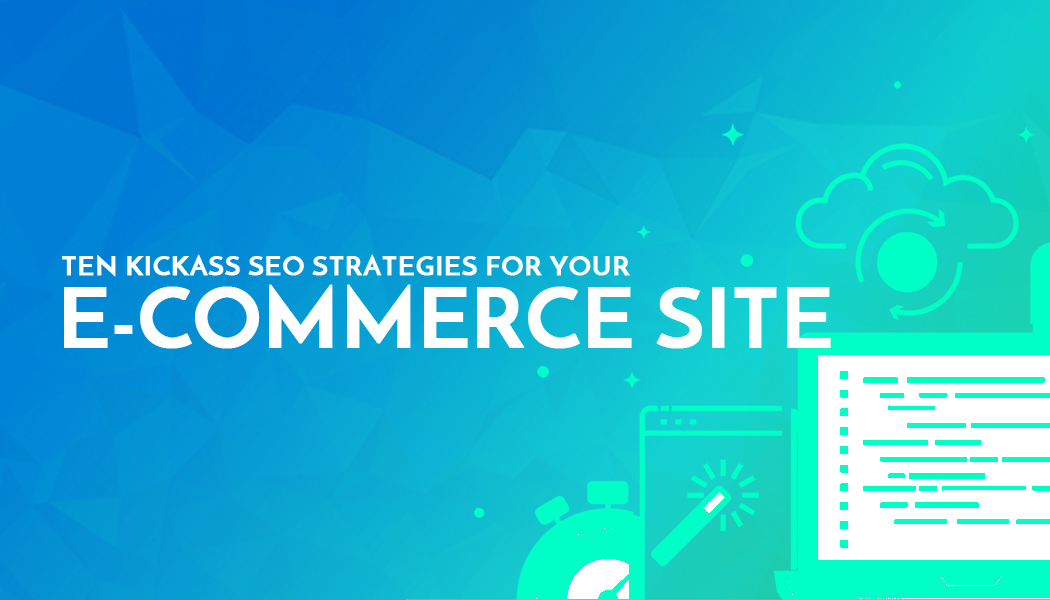Ten Kickass SEO strategies for Your E-commerce Site
Think of yourself as a potential customer, what is the first thing you usually do? Well, you Google it of course! Google helps users explore and compare the different options and provide tips and information to make the most informed decision regarding a product or service.
However, if your website just doesn’t show up on the first few pages of search results, you’re losing out on a considerable number of interested and qualified customers for your e-commerce site. Your products might occupy their place on the web, but can potential customers find them?
This is precisely why SEO for e-commerce sites is essential. It provides you with the best opportunity to reach your target audience without splurging on ads. Once people visit your site, you can turn them from visitors to customers by offering top-notch products complete with a persuasive copy and encourage calls-to-action.
Given the role it plays, here are ten SEO strategies for e-commerce sites:
1. Look At Your Competition
When you’re starting with any plan, the first step should always be to monitor competitors and determine what’s working for them. Larger competitors have already invested a lot of time, effort, and money in getting their sites optimized so you can learn a lot by observing their websites.
One aspect you especially need to keep an eye out for is keywords. In particular, you should look into the keywords they’ve used on their product pages and, also, their homepages.
Your research doesn’t just stop at keywords. You should take a look at your competitors’ landing pages and see how specific keywords are used to optimize those particular pages.
2. Include A Blog Section

Blogs are fundamental to e-commerce sites today and provide you with a multitude of benefits. First and foremost, they allow your website to attract more organic traffic since blog posts are more likely to get higher search rankings for long tail keywords related to your niche.
Blog entries have the potential to educate and inform readers and play a huge role in improving your site’s lead generation and conversions. They also enhance your site’s internal linking structure which is beneficial for your site’s ranking.
Lastly, and most importantly, it allows you to build relationships with your visitors through interaction and establishes your credibility as an industry leader through useful and engaging content.
3. Ensure Your Site is Optimized For Mobile
Yes, this is important for practically any site today, but it’s especially crucial for e-commerce platforms which, due to their complexity, would be impossible to browse on mobile devices. You should give visitors a smooth experience through a mobile design, an interactive app or responsive designs that enhance your mobile experience. The importance of mobile-optimized e-commerce sites is only going to increase in the future.
If you’re struggling with this aspect or creating your e-commerce platform in general, WordPress offers solutions to anyone looking to build a top-notch website. You can also learn how to optimize SEO to increase your reach.
4. Create Backlinks
Backlinks are an essential aspect Google focuses on to determine your overall SEO ranking. The higher the number of backlink from a high-quality site, the better your site’s authority. Building backlinks, while sounding complicated, is not that difficult. For starters, guest posts related to your target niche are an excellent way to build links.
All you need to do is reach out to the owners of some blogs and offer them a few ideas for promotional posts. If this seems too complicated, you can always reach out to a business specializing in small business SEO services to help you out. There are many agencies that offer white label link building services through which they will build links in bulk for a smaller fee.
5. Reduce the size of images to reduce load times

Regardless of how important it is to have high-quality images on your site, it's also important to remember that the higher the quality, the bigger file size. Too many high-quality pictures on one page can slow down your site, which isn't too good for your overall SEO ranking. One way around this is to compress your images to reduce their size or allow users to zoom in to see a bigger version of the picture. This will ensure your load speeds won't get compromised while keeping the quality in check too.
6. Make Your Site Easy to Navigate
If you create an ecommerce website that is difficult to use and explore, chances are users won’t be sticking around for long. The ability to navigate your site easily is extremely important to achieve higher search engine rankings and improving the experience you offer users. Product pages need to be organized smartly and categorized according to understandable and searchable categories. Your sitemap should be pretty straightforward, and the design must be top-notch and aesthetically pleasing to users.
7. Create Your Product Descriptions For Every Product
It's necessary for you to create unique product descriptions for every product you well. While it is tempting to use a manufacturer's description or repeat sections from different descriptions due to the time you'll save, these generic methods have the risk of hindering your campaign. Hence, it's always better to generate content of your own since that will pay off in the short-run and the long-run, both.
8. Add A Video To Your Product Page
You can establish greater trust within your customers by adding a video to the product page. This video can showcase your product through basic info or even a how-to video that shows how it can be used. You can, also, include testimonials from people who’ve had experience with your product.
You can also take this up a notch and use your newly-created content on platforms, such as YouTube and Facebook, as video marketing content to attract potential customers to your site.
Once people have a better idea on how your product can be used, there’s a greater chance they’ll end up spending on it
9. Integrate Product Pages With Social Sharing
Apart from basic social integration, you must provide buttons so visitors can share your content with their followers on their respective social media profiles. This is a business practice that is generally applicable, but one that's especially useful for SEO since Google often uses social signals as a measure of authority.
10. Encourage Users To Leave Reviews
There is nothing that can boost the popularity of your product like a recommendation from another user. Every time you make a sale, you should encourage users to leave reviews on each product page. The best example for you to look at is Amazon. Every product has its own set of reviews with a star rating.
Not just this, but Google picks up on content that adds value and, for an e-commerce site, these user reviews are a great way to come up with free content. Plus, positive reviews always boost your sales since they increase the credibility of your brand.
By incorporating these strategies on your e-commerce site as soon as possible, you’ll be able to see your business grow substantially. Unlike other sites, e-commerce sites come with their own set of challenges, but, with proper implementation of effective SEO strategies, you can easily succeed.
Have you ever tried any of these strategies? Or do you have suggestions of your own? Sound off in the comments below!




